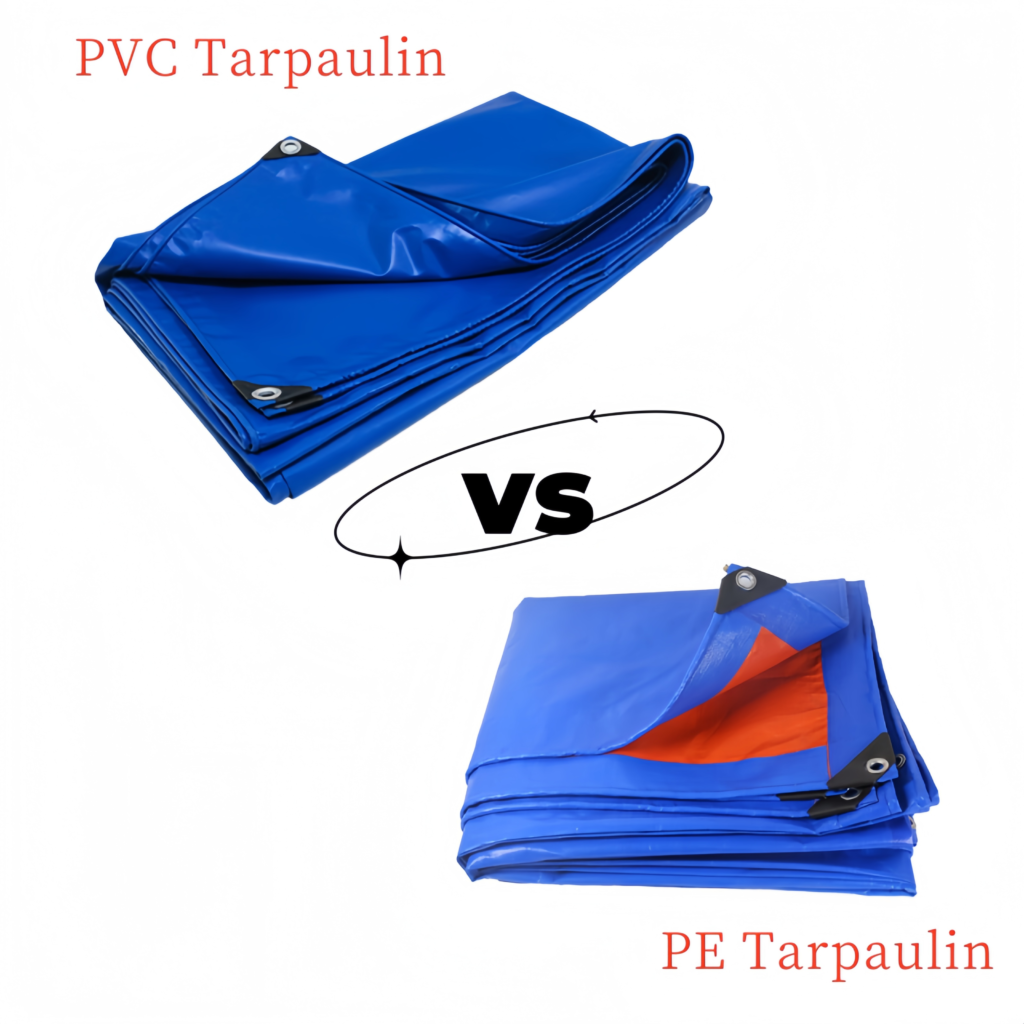When choosing tarpaulins, many customers often feel confused and don’t know how to make a choice between PE tarpaulins and PVC tarpaulins. There are obvious differences between the two in terms of material, weather resistance, weight, and price, and different usage environments and demands put forward different requirements for the performance of tarpaulins. Customers often worry that choosing the wrong materials will affect the service life and effect of the tarpaulin, while at the same time hoping to obtain the best cost performance within the budget. This multiple consideration makes the choice complex and difficult, requiring professional guidance and detailed product comparisons to assist in decision-making.
How to Choose PE Tarpaulin or PVC Tarpaulin?

Comparison of PE Tarpaulin and PVC Tarpaulin
The table below summarizes the advantages and disadvantages of PE and PVC tarpaulins, helping you choose the most suitable material based on your needs.
| Feature | PE Tarpaulin | PVC Tarpaulin |
| Material Structure | Polyethylene woven fabric with good breathability | Polyvinyl chloride material with strong sealing |
| Weight | Light, easy to carry and install | Heavier, sturdy structure |
| Weather Resistance | Moderate, prone to aging, weaker UV resistance | Excellent, UV resistant, waterproof, mold resistant |
| Waterproofing | Average, prone to leakage | Excellent, fully waterproof |
| Service Life | Shorter, suitable for temporary or short-term use | Longer, suitable for long-term outdoor use |
| Cost | Low, economical | Higher, cost-effective due to durability |
| Applications | Temporary cover, light-duty coverage, agricultural use | Heavy-duty coverage, industrial protection, long-term use |
| Repairability | Easily torn, difficult to repair | Durable, easy to repair |
How to customize tarpaulins according to your own needs?
1. Clarify the purpose and scenario.
Determine the main functions of the tarpaulin (shading, rain protection, goods coverage, advertising and promotion, etc.);
Understand the usage environment (indoor, outdoor, long-term, or temporary use).
2. Determine the size and shape.
Measure the area to be covered and determine the accurate length, width, and height.
Choose the appropriate shape according to the usage scenario, such as flat rectangle, tent shaped, arc shaped, etc.
3. Choose the appropriate material.
Choose PE, PVC, or other materials based on weather resistance, wear resistance, weight, and budget.
Consider whether special functions such as fire prevention and UV protection are needed.
4. Design the structure and details.
Decide whether the edges of the tarpaulin need to be reinforced, sewn, drilled, or equipped with straps, zippers, etc.
Select the matching accessories, such as retaining rings, ropes, iron rings, etc., to facilitate installation and fixation.
5. Color and printing requirements
Determine the color of the tarpaulin and whether it is necessary to print the company LOGO, promotional text, or patterns.
Provide high-quality design documents to ensure clear printing effects.
6. Sample confirmation and mass production
First, make samples to confirm the size, material and printing quality.
After the samples are confirmed to be correct, mass production is carried out and quality control is conducted.
7. Packaging and Delivery
Design appropriate packaging according to transportation requirements to ensure the products are delivered intact.
Confirm the delivery time and arrange the logistics distribution.
By following the above steps, you can scientifically customize tarpaulin products that meet your own needs and achieve the best usage effect.
What is the difference in the tarpaulin material?
Comparison of Tarpaulin Material: Virgin, Recycled, and Blend
The table below compares the characteristics of tarpaulin materials made from virgin, recycled, and blended raw materials, helping you understand their differences and applications.
| Feature | Virgin Material | Recycled Material | Blend of Virgin & Recycled |
| Raw Material Source | 100% new polymer | Recycled plastic pellets or reprocessed old tarpaulins | Mix of virgin and recycled materials in certain proportions |
| Quality Stability | High, excellent performance | Unstable, large performance variation | Better than recycled alone but inferior to virgin |
| Strength & Weather Resistance | Strong, tear-resistant, UV-resistant, anti-aging | Weaker, prone to aging and damage | Moderate, between virgin and recycled |
| Color & Appearance | Bright and long-lasting | Uneven color, fades easily | Generally good but slightly inferior to virgin |
| Application Scenarios | Long-term outdoor use, heavy-duty environments | Short-term use, low-strength requirements | Medium performance, suitable for moderate use |
| Environmental Friendliness | Average | Good, promotes resource recycling | Moderate |
| Price | Highest | Lowest | Moderate |
Conclusion
When choosing tarpaulins, the appropriate material and specification should be selected based on the usage environment and requirements. Consider the weather resistance, water resistance, and strength of the tarpaulin to ensure that it can withstand wind, rain, and ultraviolet erosion. The size should be precise to facilitate covering or protecting the target object. Choose a reputable manufacturer and pay attention to whether the materials are brand new to ensure durability. Finally, by combining the budget and the usage period, balance the cost and performance to ensure the best cost performance.
If you have any doubts about how to choose the right tarpaulins, contact Ningbo Toprise to help you solve the problems.


